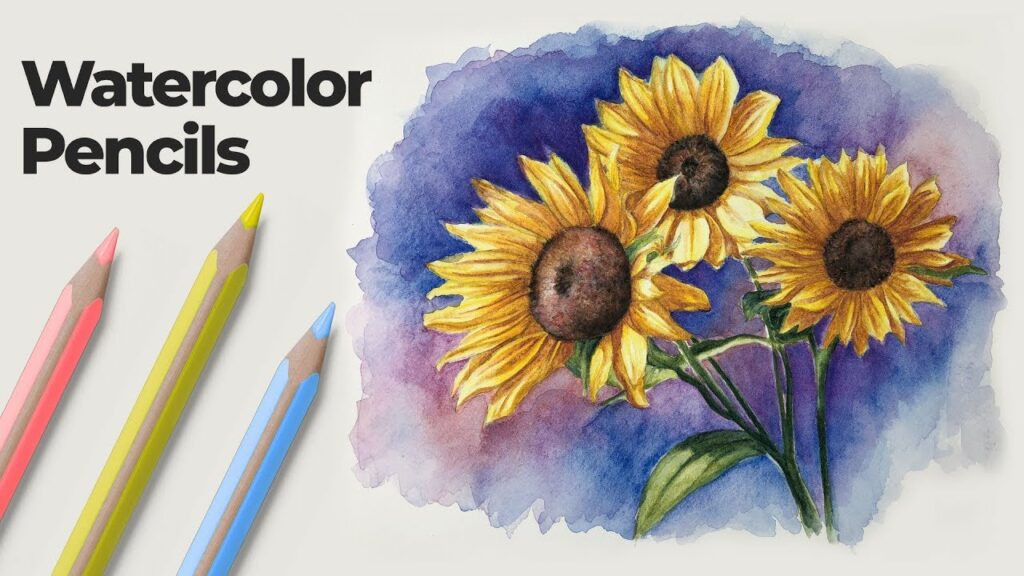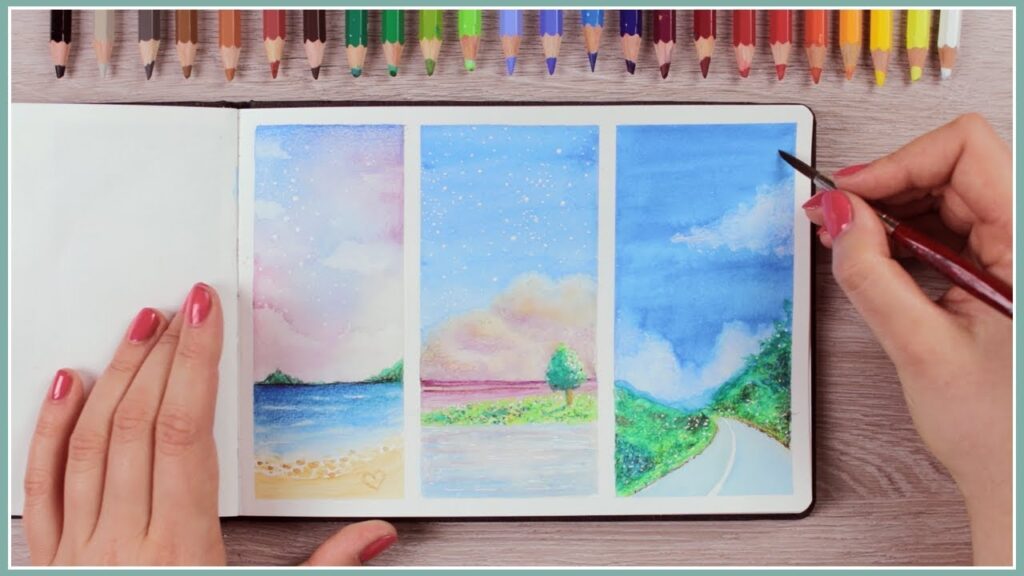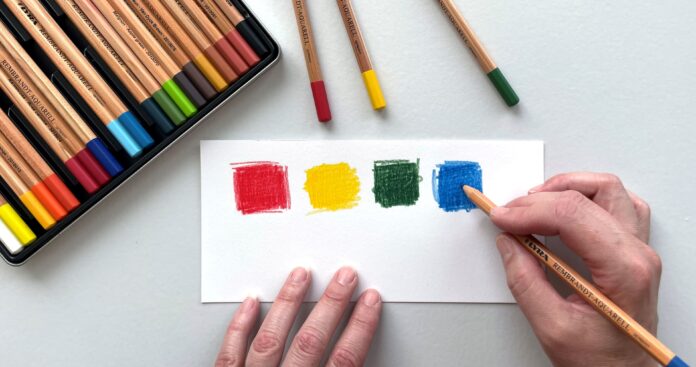Watercolor pencils are a special type of art tool that can help you make beautiful and colorful drawings. Unlike regular colored pencils, watercolor pencils can turn into paint when you add water. This makes watercolor pencils super cool for creating amazing artwork with different effects.
Using watercolor pencils is easy and fun. You can draw with them just like you would with regular pencils, but when you add water, the colors blend together like watercolor paints. This gives your art a smooth and vibrant look that’s perfect for all kinds of creative projects.
What Are Watercolor Pencils?
Watercolor pencils are special art tools that combine the features of colored pencils and watercolor paints. These pencils look like regular colored pencils, but they have a special property: they can turn into paint when you add water. This unique feature makes watercolor pencils fun to use for creating colorful artwork.
When you draw with watercolor pencils, the color is dry and can be sharpened just like any other pencil. Once you apply water, the color spreads out and blends together, similar to how watercolor paint behaves. This ability to transform from a pencil to paint allows artists to create interesting and vibrant effects.
If you’re new to using watercolor pencils, you’ll find they’re easy to handle. Start by drawing with the pencil on your paper. Then, use a brush and water to blend the colors. This simple process opens up a whole new world of artistic possibilities.
How Do Watercolor Pencils Work?
Watercolor pencils work by using a special water-soluble binder that allows the color to dissolve when water is added. This binder is different from the one used in regular colored pencils, which means that watercolor pencils can create unique effects on paper.
When you draw with watercolor pencils, the color stays on the paper in a dry form. Adding water activates the binder, turning the color into a paint-like substance. This lets you blend and mix colors just like you would with traditional watercolor paints.
The more water you use, the more the color will spread and blend. If you use only a little water, you’ll see some pencil strokes and texture in your artwork. Adding more water makes the color smoother and more blended, giving your art a soft, painted look.
The Benefits of Using Watercolor Pencils
One of the biggest benefits of using watercolor pencils is their versatility. You can use them dry or wet, depending on the effect you want to achieve. Drawing with them dry gives you sharp, defined lines, while adding water makes the colors blend and flow like watercolor paint.
Another advantage is the color saturation. When you apply water to watercolor pencils, the color becomes more intense and vivid. This happens because the water dissolves the binder, allowing the pigment to spread evenly across the paper. This results in brighter and more saturated colors.
Watercolor pencils are also easy to use for layering techniques. You can apply different colors on top of each other and use water to blend them smoothly. This layering process lets you create complex and rich color effects without needing a lot of different art supplies.
Color Mixing with Watercolor Pencils

Color mixing with watercolor pencils is simple and fun. When you use these pencils, you can layer different colors on top of each other to create new shades. By adding water, you can blend these colors smoothly, just like mixing paint on a palette.
To start mixing colors, draw with different watercolor pencils on your paper. Then, use a wet brush to blend the colors together. This will create a seamless transition between colors and give your artwork a smooth, painterly look.
The amount of water you use affects how well the colors mix. A little water will let you see some of the pencil strokes, while more water will make the colors blend more completely. Experiment with different amounts of water to see how it changes your color mixes.
Tips for Drawing with Watercolor Pencils
When drawing with watercolor pencils, start with light layers of color. This way, you can build up the color gradually and avoid making it too dark too quickly. Light layers are easier to blend and adjust with water.
Use a sharp pencil for detailed lines and small areas. A sharp point helps you control the color application more precisely. For larger areas, you can use a slightly duller pencil to cover more space with color.
Another tip is to use high-quality paper designed for watercolor pencils. Paper with a good texture will help the colors blend better and show off the watercolor effects more clearly. Paper that is too smooth may not hold the color as well.
How to Create Intense Colors with Watercolor Pencils
To create intense colors with watercolor pencils, start by applying a heavy layer of pencil on your paper. The more color you lay down, the more vibrant and saturated the final result will be when you add water.
Next, use a generous amount of water to dissolve the binder and spread the color. The water helps the pigment cover more of the paper and blend more smoothly. This creates a rich and deep color effect.
Keep in mind that the type of paper you use also affects the color intensity. Heavier and textured papers will hold more pigment and give you more vibrant colors compared to lighter papers.
Fun Techniques for Using Watercolor Pencils
There are many fun techniques you can try with watercolor pencils to make your art unique. One technique is drawing on wet paper. First, wet your paper, then draw with watercolor pencils. The color will blend and spread in interesting ways.
Another fun technique is dipping the pencil tip in water before drawing. This makes the color more intense and adds a different texture to your artwork. It’s a great way to experiment with various effects and find what works best for you.
You can also use a wet brush to pick up color directly from the pencil tip. This method lets you apply the color to your paper in a painterly way, giving your artwork a soft, watercolor-like finish.
Watercolor Pencils vs. Regular Colored Pencils
Watercolor pencils and regular colored pencils have some key differences. Regular colored pencils use a wax or oil binder, which means the color stays dry and doesn’t blend like paint. On the other hand, watercolor pencils use a water-soluble binder, which lets the color turn into paint when water is added.
Regular colored pencils are great for detailed drawings with crisp lines and textures. They are perfect for shading and creating fine details. Watercolor pencils, however, are more versatile because they can blend and mix colors with water, giving you a painterly effect.
Both types of pencils have their own benefits. Regular colored pencils are excellent for precise, controlled work, while watercolor pencils offer more creative possibilities with their ability to turn into paint. Choosing between them depends on the effect you want to achieve in your artwork.
How to Apply Watercolor Pencils for Beautiful Effects
Applying watercolor pencils correctly can create stunning effects in your art. Start by drawing lightly with the pencil to build up color gradually. This allows you to create smooth transitions and blends when you add water.
After drawing, use a brush and water to blend the colors. You can apply a small amount of water for a more textured look or more water for a smoother blend. This will help you achieve the effect you want in your artwork.
Try applying the pencil in different ways, such as layering colors or using a wet brush to pick up color from the pencil tip. Each method will give you different results, so experimenting will help you find the best technique for your project.
Exploring Different Textures with Watercolor Pencils
Watercolor pencils can create a variety of textures in your art. One way to explore textures is by applying the pencils dry and then adding water. The water will blend the color and create a smooth, painterly texture.
Another method is drawing on wet paper. This technique allows the color to mix and spread in interesting ways, giving you a unique texture that’s different from drawing on dry paper. It’s a great way to experiment and see how water affects the color.
You can also try dipping the pencil in water before drawing. This creates a grainy texture that adds depth and character to your artwork. Each of these techniques can give your art a different look and feel.
Using Watercolor Pencils on Wet Paper
Using watercolor pencils on wet paper is a fun and creative technique. First, wet your paper with a brush or spray bottle. Then, draw with watercolor pencils directly on the wet surface. The color will blend and spread in interesting ways, creating a unique effect.
This method allows you to achieve bold strokes and smooth color transitions. The wet paper helps the color mix more freely, giving you a painterly look that’s different from drawing on dry paper.
Keep in mind that the amount of water on the paper will affect the result. More water will create a softer blend, while less water will give you more control over the color spread. Experiment with different water levels to see what works best for your artwork.
How to Mix Colors Using Watercolor Pencils
Mixing colors with watercolor pencils is easy and fun. Start by drawing with different colors on your paper. Then, use a brush and water to blend the colors together. This will create a smooth transition and a beautiful color mix.
You can also layer colors before adding water. Apply one color, then add another color on top. When you add water, the colors will mix and blend, creating new shades and effects. This layering technique helps you create more complex and rich colors.
The amount of water you use will affect how well the colors mix. A little water will give you a more textured look, while more water will create a smoother blend. Experiment with different amounts to see how they change the color mixing.
Creative Ways to Use Watercolor Pencils in Your Art
There are many creative ways to use watercolor pencils in your art. One idea is to create a background with watercolor pencils and then draw details on top. The background can be blended with water for a soft, painterly effect, while the details can be added with dry pencil.
Another creative technique is to use watercolor pencils to make texture in your artwork. Apply the pencil in different ways, such as dry, wet, or with a dipped tip, to create various effects. This will add depth and interest to your art.
You can also try using watercolor pencils for mixed media projects. Combine them with other art supplies, like markers or ink, to create unique and layered artwork. This allows you to experiment and find new ways to use your watercolor pencils.
Choosing the Right Paper for Watercolor Pencils
Choosing the right paper is important when using watercolor pencils. Look for paper that is designed for watercolor or mixed media. This type of paper has a texture that helps hold the color and blend it smoothly.
Heavier paper is usually better because it can handle the water without warping. Look for paper with a weight of 200 lb (425 gsm) or more for the best results. Heavier paper also allows you to use more water without damaging the surface.
Paper with a rough or textured surface can add interesting effects to your artwork. The texture will show through in the final piece, giving your colors a unique look. Experiment with different types of paper to find what works best for you.
Dipping Watercolor Pencils in Water: What You Need to Know
Dipping watercolor pencils in water is a fun technique that can create different effects in your art. Start by dipping the tip of the pencil in water. This will dissolve the outer layer of binder, making the color more intense.
After dipping the pencil, draw on your paper. The color will be more vivid and spread differently than when you use the pencil dry. This technique creates a grainy texture that adds depth to your artwork.
Keep in mind that the amount of water you dip the pencil in affects the result. A quick dip will give a lighter effect, while a longer dip will make the color more intense and blended. Experiment to see what works best for your project.
Layering Techniques with Watercolor Pencils
Layering techniques with can help you create rich and complex artwork. Start by applying a light layer of color to your paper. Then, add another layer of a different color on top. This will build up the color and create interesting effects.
After layering the colors, use water to blend them together. The water will help the colors mix and blend smoothly, giving you a painterly look. You can adjust the amount of water to control the blend and texture.
Experiment with different layering techniques, such as layering multiple colors or adding water between layers. Each technique will give you different results, so try various methods to find what works best for your art.
How to Fix Mistakes with Watercolor Pencils
Fixing mistakes with can be easy if you know a few tricks. If you make a mistake, let the paper dry completely first. Once it’s dry, you can erase any unwanted pencil marks gently. A kneaded eraser works well for this purpose, as it lifts the color without damaging the paper.
If erasing doesn’t work, you can use water to correct the mistake. Apply a small amount of water to the area with a brush to dilute the color. Blot the excess water with a clean tissue or cloth. This can help lighten the area and make it easier to correct.
Another method is to use additional layers of color to cover mistakes. Draw over the mistake with a new color, then use water to blend it. This can help mask errors and integrate them into your artwork.
Creating Depth and Dimension with Watercolor Pencils
Creating depth and dimension with can make your artwork more dynamic. Start by using different shades of the same color. Apply darker shades where you want shadows and lighter shades where you want highlights.
Add water to blend these colors together. The blending will create smooth transitions between light and dark areas, giving your artwork a three-dimensional look. This technique helps make objects appear more realistic and adds depth to your drawing.
Another way to add dimension is by layering colors. Apply multiple layers of different colors, then use water to blend them. This will create rich, textured effects and enhance the depth of your artwork.
Exploring Different Styles with Watercolor Pencils

Exploring different styles with can be exciting and rewarding. One style to try is a wash effect, where you apply a light layer of color and then use water to spread it across the paper. This creates a soft, watercolor-like look.
Another style is the dry brush technique, where you use a dry watercolor pencil to make textured strokes. Adding water to these strokes will enhance the texture and create a unique appearance in your artwork.
You can also experiment with blending techniques, such as wet-on-wet or wet-on-dry. Wet-on-wet involves applying water to the paper before drawing with pencils, while wet-on-dry involves drawing first and then adding water. Each method will give you different results.
Storing and Caring for Your Watercolor Pencils
Properly storing and caring for your will help keep them in good condition. Store your pencils in a cool, dry place to prevent them from breaking or getting damaged. Avoid exposing them to extreme temperatures or direct sunlight.
Keep your in a case or holder to protect them from damage. This will also help prevent the tips from getting crushed or worn down. Sharpen your pencils regularly to maintain a good drawing point.
Clean your by wiping them gently with a dry cloth if they get dirty. Avoid using water or cleaning solutions, as these can damage the pencils and affect their performance.
Conclusion
It are a fun and versatile art tool that can help you create beautiful artwork. Whether you use them dry or with water, they offer lots of creative possibilities. By trying out different techniques like blending, layering, and using wet paper, you can discover many ways to make your art look amazing.
So, grab your and start experimenting! With a bit of practice, you’ll be able to make vibrant and colorful drawings that stand out. Enjoy exploring all the cool things you can do with and let your creativity shine!

